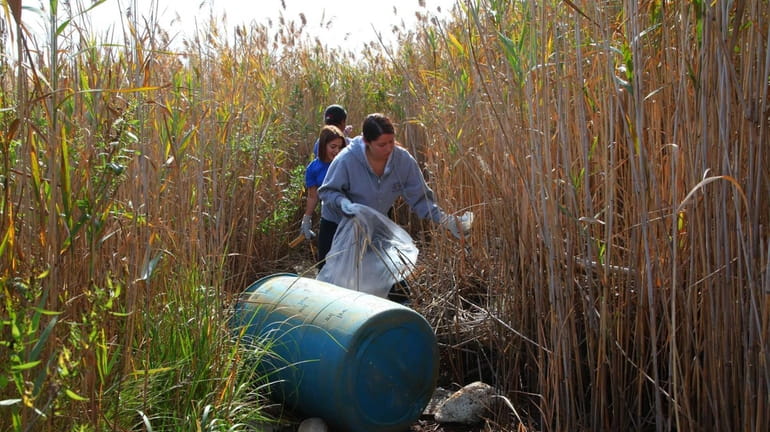LI coast communities to get nearly $16.8M in federal aid

Jamie Morgenstern, in gray, and Leah Convertino along with other Long Beach High School students, help clean up of a 35-acre salt marsh in Long Beach. (Oct. 3, 2013) Credit: Howard Schnapp
Nearly $16.8 million targeted for Long Island will help restore salt marshes, extend a waterside boardwalk and give coastal communities resiliency against superstorms like Sandy, federal officials said Thursday.
The money was part of $162 million slated by the Interior Department for 45 restoration and research projects in communities damaged a year ago by Sandy.
The Island's main chunk, more than $11 million, will rebuild 432 acres of salt marshes at two national wildlife refuges -- Seatuck in Islip and Wertheim in Shirley -- and repair and extend a boardwalk over the marshes at the Lido Beach National Wildlife Refuge.
Michelle Potter, manager of the Long Island National Wildlife Refuge Complex, said the salt marshes have been declining for decades, washed away by storms and crowded out by invasive reeds.
During Sandy, they were not strong enough to buffer communities from flooding, leading to more damage and breaches, she said. "When the marshes are functioning healthy, they can take the brunt of the storm," Potter said.
To strengthen salt marshes, native grass will be planted, while invasive species will be culled over the next few years, through methods that include controlled burns and herbicides, she said.
At Lido Beach, crews will repair and extend the boardwalk used by Long Beach school students to study the marshes and wildlife, officials said.
Another project will allow the U.S. Geological Survey to map the seabeds off Fire Island -- a "baseline" picture of how Sandy changed the topography and habitats, said Cheryl Hapke, a coastal geologist with the agency.
The research will also help predict changes and vulnerabilities caused by storms, sea level rises and human activities, officials said. "It's a comprehensive effort in the long run to understand the coastal systems and the resiliency of the coastal systems," Hapke said.
Under the project, devices will be placed on the seabed to monitor sand and sediment, she said: "The sand that makes its way ultimately to the beaches -- to this day, we don't understand how that sand moves, where it moves and how quickly it moves."
In another project, $900,000 will go to studying how marine habitats and water quality were changed by breaches at the Fire Island National Seashore.

Updated now Newsday travel writer Scott Vogel took the ferry over to Block Island for a weekend of fun.

Updated now Newsday travel writer Scott Vogel took the ferry over to Block Island for a weekend of fun.

